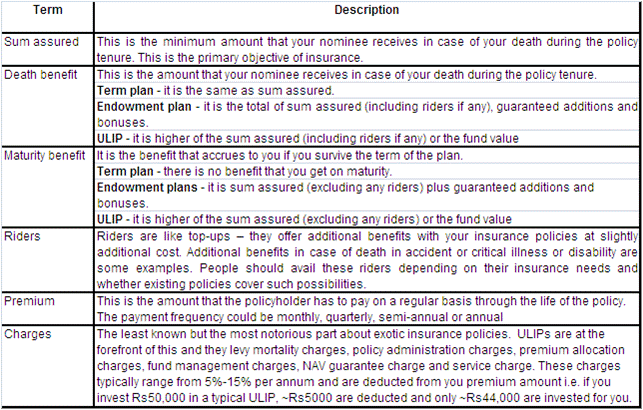Why does Prospero Tree recommend you to read this article?
Over the last few years, life insurance has evolved from being a plain vanilla product to one of the most complicated financial product. There are approximately 24 life insurers offering more than 200 different plans ranging from term insurance, endowment plans and ULIPs each promising to offer you a part or combination of insurance, saving and investment. The complexities generally force an individual buyer to rely on the salesperson for his decision making. This article aims to help you
- Understand the product complexities and common terminologies in life insurance
- Understand the need and the type of product that should be purchased
Term insurance the simplest form of life insurance
These are plans where you pay an annual premium and the company insures you for the pre-agreed term. In case you live through the term, no benefit accrues to you. Consider a 30 year old male seeking to insure himself to the tune of Rs. 25,00,000. A typical LIC term plan will insure him for that amount upto the age of 55 years on annual payment of Rs. 8,000. (Online term policies of certain private insurers are still cheaper) In case the person dies before he turns 55, his nominee will be paid Rs. 25,00,000. The person gets nothing if he lives beyond 55 years.
Endowment plans insurance plus savings
The primary reason for introduction of these products is Indian consumers discomfort with the concept of not getting any money back when the policy expires. Endowment plans combine insurance with savings. The surviving policyholder gets back the corpus amount i.e. the premium amount plus the returns generated on the premium amount over the life of the policy. A 30 year old desirous of insuring himself to the tune of Rs. 25,00,000 up to the age of 55 years will have make a payment of about Rs 100,000 per year. At the end of the tenure, he gets back his investment amount along with the returns earned. Historical data suggests that endowment plans have delivered ~6% compounded annual growth rate. This is much lower than the long term returns generated by PPF or even fixed deposits.
Unit linked insurance plans (ULIPs) - insurance plus investments
Capitalizing on concept of getting money back, the private insurance companies packaged insurance with stock market investments in a product called ULIPs. These plans typically invest 60% to 100% of your premium in the stock markets and the returns that you get at the end of the policy are dependent on the performance of investments made by the ULIP. Although ULIPs don't have a long term track record, returns on most ULIPs have been lower than Sensex returns due to the host of charges levied on the unaware policyholder (Read: Insurance - Wisdom in simplicity). The charges could be in the range of 5% to 15% of your premiums. (Read: Ulips - Low on insurance, high on charges)


The terminologies used in the insurance space are not too intuitive. Hence, we first try and breakdown the common terminologies used across the industry and then compare the various insurance products available in the market.


Prospero Tree view
At Prospero Tree, we are of the opinion that insurance products should be used for the pure purpose of insuring your life. Buying complex products like ULIPs often leaves you with less of an insurance component and more of an investment component. It is always a good idea to 1) Buy a term insurance and a mutual fund instead of ULIP or 2) A term insurance and PPF instead of endowment plan. In this way, you end up earning higher returns and paying lower charges at the same time, meeting the most important objective of insurance getting a good sum assured in case of untimely death.

